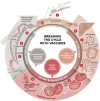Vaccines against malaria
- PMID: 25452593
- PMCID: PMC4357819
- DOI: 10.1093/cid/ciu954
Vaccines against malaria
Abstract
Despite global efforts to control malaria, the illness remains a significant public health threat. Currently, there is no licensed vaccine against malaria, but an efficacious vaccine would represent an important public health tool for successful malaria elimination. Malaria vaccine development continues to be hindered by a poor understanding of antimalarial immunity, a lack of an immune correlate of protection, and the genetic diversity of malaria parasites. Current vaccine development efforts largely target Plasmodium falciparum parasites in the pre-erythrocytic and erythrocytic stages, with some research on transmission-blocking vaccines against asexual stages and vaccines against pregnancy-associated malaria. The leading pre-erythrocytic vaccine candidate is RTS,S, and early results of ongoing Phase 3 testing show overall efficacy of 46% against clinical malaria. The next steps for malaria vaccine development will focus on the design of a product that is efficacious against the highly diverse strains of malaria and the identification of a correlate of protection against disease.
Keywords: P. falciparum; P. vivax; malaria; vaccine.
© The Author 2014. Published by Oxford University Press on behalf of the Infectious Diseases Society of America. All rights reserved. For Permissions, please e-mail: journals.permissions@oup.com.
Figures

Similar articles
-
The march toward malaria vaccines.Vaccine. 2015 Nov 27;33 Suppl 4(Suppl 4):D13-23. doi: 10.1016/j.vaccine.2015.07.091. Epub 2015 Aug 29. Vaccine. 2015. PMID: 26324116 Free PMC article. Review.
-
Malaria vaccine: a current perspective.J Vector Borne Dis. 2008 Mar;45(1):1-20. J Vector Borne Dis. 2008. PMID: 18399312 Review.
-
Genetic analysis of ID1-DBL2X predicts its validity as a vaccine candidate in Colombia and supports at least two independently introduced Plasmodium falciparum populations in the region.Infect Genet Evol. 2017 Nov;55:175-185. doi: 10.1016/j.meegid.2017.09.003. Epub 2017 Sep 8. Infect Genet Evol. 2017. PMID: 28893687
-
Global genetic diversity of var2csa in Plasmodium falciparum with implications for malaria in pregnancy and vaccine development.Sci Rep. 2018 Oct 18;8(1):15429. doi: 10.1038/s41598-018-33767-3. Sci Rep. 2018. PMID: 30337594 Free PMC article.
-
Genetic diversity of VAR2CSA ID1-DBL2Xb in worldwide Plasmodium falciparum populations: impact on vaccine design for placental malaria.Infect Genet Evol. 2014 Jul;25:81-92. doi: 10.1016/j.meegid.2014.04.010. Epub 2014 Apr 21. Infect Genet Evol. 2014. PMID: 24768682
Cited by
-
Complement in malaria: immune evasion strategies and role in protective immunity.FEBS Lett. 2020 Aug;594(16):2502-2517. doi: 10.1002/1873-3468.13772. Epub 2020 Apr 1. FEBS Lett. 2020. PMID: 32181490 Free PMC article. Review.
-
Accelerator or Brake: Immune Regulators in Malaria.Front Cell Infect Microbiol. 2020 Dec 10;10:610121. doi: 10.3389/fcimb.2020.610121. eCollection 2020. Front Cell Infect Microbiol. 2020. PMID: 33363057 Free PMC article. Review.
-
Peptides for Vaccine Development.ACS Appl Bio Mater. 2022 Mar 21;5(3):905-944. doi: 10.1021/acsabm.1c01238. Epub 2022 Feb 23. ACS Appl Bio Mater. 2022. PMID: 35195008 Free PMC article. Review.
-
An expanding toolkit for preclinical pre-erythrocytic malaria vaccine development: bridging traditional mouse malaria models and human trials.Future Microbiol. 2016 Dec;11(12):1563-1579. doi: 10.2217/fmb-2016-0077. Epub 2016 Nov 18. Future Microbiol. 2016. PMID: 27855488 Free PMC article. Review.
-
Cytolytic circumsporozoite-specific memory CD4+ T cell clones are expanded during Plasmodium falciparum infection.Nat Commun. 2023 Nov 25;14(1):7726. doi: 10.1038/s41467-023-43376-y. Nat Commun. 2023. PMID: 38001069 Free PMC article.
References
-
- World Health Organization. Geneva, Switzerland: World Health Organization; World Malaria Report: 2013.
-
- Malaria Vaccine Technology Roadmap. Malaria Vaccine Funders Group. World Health Organization. 2013. Available at: http://www.who.int/immunization/topics/malaria/vaccine_roadmap/en/
-
- Freund J, Thomson KJ, Sommer HE, Walter AW, Schenkein EL. Immunization of rhesus monkeys against malarial infection (P. knowlesi) with killed parasites and adjuvants. Science. 1945;102:202–4. - PubMed
-
- Clyde DF, Most H, McCarthy VC, Vanderberg JP. Immunization of man against sporozite-induced falciparum malaria. Am J Med Sci. 1973;266:169–77. - PubMed
Publication types
MeSH terms
Substances
Grants and funding
LinkOut - more resources
Full Text Sources
Other Literature Sources
Medical

